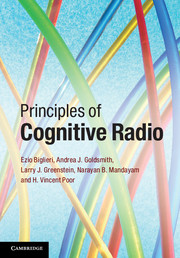Preface
Published online by Cambridge University Press: 05 December 2012
Summary
The radio spectrum is one of the most important resources for communications. Traditionally, spectrum governance throughout the world has tended towards exclusivity of its use in large geographic areas, allocating frequency bands for specific applications and assigning licenses to specific users or service providers. This policy has generated a shortage of frequencies available for emerging wireless products and services, as most frequencies are now assigned. Moreover, exclusivity creates underutilization of the spectrum, as very rarely can all licensees make full use of the frequencies assigned to them. These facts have motivated the search for technologies able to alleviate the artificial scarcity of spectrum by adapting to changing environmental and network-usage conditions.
What is perhaps the most natural among these technologies involves opportunistic use of the spectrum, whereby secondary (unlicensed) users are able to occupy the portions of the spectrum left temporarily free by the licensed primary users. The stringent requirement here is that secondary users should not interfere with the primary users, which this paradigm of operation (later called interweaving) achieves using the simplest form of orthogonalization, one that only requires knowledge of the state of a frequency band, i.e., whether it is free or occupied. The fact that the spectrum can be shared by primary and secondary users, with the latter exploiting their cognition of the environment in which transmission is taking place, has led to the development of the concept of Cognitive Radio (CR), whose idea was first introduced in [1] in 1999.
- Type
- Chapter
- Information
- Principles of Cognitive Radio , pp. xv - xviiPublisher: Cambridge University PressPrint publication year: 2012

